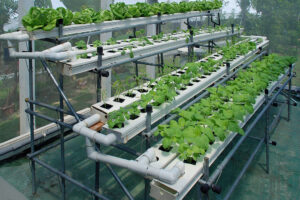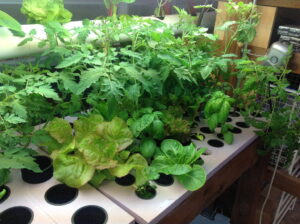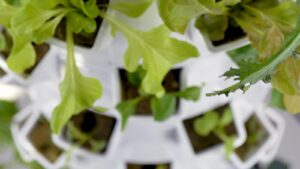Welcome to the world of hydroponics, where gardening reaches new heights without the reliance on soil. Imagine yourself cultivating a thriving garden indoors, without the limitations imposed by the seasons or traditional gardening methods. Hydroponics is not just a hobby, but a rewarding opportunity to explore the science of nourishing your plants with precision and care. In this article, we delve into the realm of DIY hydroponic nutrient solutions – the essential concoctions that provide the lifeblood for your plants. Join us as we unlock the secrets behind creating a harmonious and balanced formula, paving the way for an abundant and flourishing harvest. Whether you are a seasoned hydroponics enthusiast or simply curious about this innovative gardening technique, prepare to embark on a journey of discovery as we demystify the art of nutrient solution creation. So, put on your green thumb and let’s dive into the fascinating world of DIY hydroponic nutrient solutions together!
Mixing the Basics: Understanding the Elements of a DIY Hydroponic Nutrient Solution
As a hydroponic enthusiast, creating your own nutrient solution can be a rewarding experience. By understanding the elements that make up a balanced formula, you can fine-tune your mix to suit the specific needs of your plants. Let’s dive into the world of DIY hydroponic nutrient solutions and unravel the secrets to creating a harmonious blend that will maximize your plant’s growth and yield.
First and foremost, it is crucial to grasp the three fundamental components that form a well-rounded hydroponic nutrient solution: macronutrients, micronutrients, and supplements. Macronutrients, such as nitrogen, phosphorus, and potassium, are essential for plant growth and play a vital role in various physiological processes. Micronutrients, on the other hand, are required in smaller quantities but are equally important for optimal plant health. These include trace elements like iron, manganese, and zinc.
Creating a balanced formula means achieving the ideal ratio of these nutrients. A general guideline to begin with is a ratio of 3:1:2 for NPK (nitrogen, phosphorus, and potassium) respectively. However, plant species and growth stages may call for different ratios. Experimentation and observation will help you fine-tune your formula over time. Additionally, supplements such as calcium and magnesium can be added to address specific deficiencies and promote healthier plant development.
Fine-Tuning the Formula: Essential Nutrients for Optimal Plant Growth
Creating a balanced DIY hydroponic nutrient solution is the key to achieving optimal plant growth. While there are ready-made nutrient solutions available in the market, nothing beats the satisfaction of crafting your own formula tailored to your plant’s specific needs. By understanding the essential nutrients required for plant growth and fine-tuning their ratios, you can ensure your hydroponic plants thrive and produce healthy yields.
When it comes to formulating your DIY nutrient solution, it’s crucial to consider the primary macronutrients: nitrogen (N), phosphorus (P), and potassium (K). These nutrients play a vital role in different aspects of plant growth. Nitrogen promotes leafy growth and enhances overall plant vigor, phosphorus aids in root development and flower production, while potassium improves disease resistance and regulates important physiological functions.
However, achieving a balanced nutrient solution isn’t just about macronutrients; it also involves incorporating essential micronutrients. Micronutrients like iron (Fe), manganese (Mn), zinc (Zn), and others may be required in trace amounts but are equally critical for various plant functions. They act as catalysts for enzyme reactions, aiding plant metabolism and overall health. Remember to pay close attention to their concentration, as both a deficiency and an excess of micronutrients can adversely affect plant growth.
Beyond NPK: Unlocking the Secret Ingredients for a Balanced Hydroponic Solution
When it comes to hydroponic nutrient solutions, most growers focus solely on the three main macronutrients: nitrogen (N), phosphorus (P), and potassium (K). While these nutrients are undoubtedly crucial for plant growth, overlooking the other essential elements can lead to imbalance and suboptimal results. Today, we’re diving deeper into the world of hydroponics to unlock the secret ingredients that can take your plants to the next level!
1. Micronutrients: Often overlooked but oh-so-important, micronutrients are essential elements that plants require in small quantities. These include iron, manganese, zinc, copper, boron, molybdenum, and chlorine. Although they are needed in trace amounts, micronutrients play a vital role in enzyme reactions, photosynthesis, and overall plant health. Adding a well-balanced mix of micronutrients to your hydroponic solution ensures your plants have all the necessary building blocks for robust growth.
2. Calcium and Magnesium: Calcium (Ca) and magnesium (Mg) are not only essential nutrients themselves but also play a crucial role in maintaining pH balance. Calcium aids in cell wall formation, root and shoot development, and enzymatic functions, while magnesium is a central component of the chlorophyll molecule. Adding ample amounts of these elements to your solution not only promotes plant strength but also helps prevent nutrient deficiencies and pH fluctuations.
3. Supplements and Additives: While a well-balanced formula should cover most of your plant’s nutritional needs, there are additional supplements and additives that can elevate their growth even further. For example, amino acids can enhance protein synthesis and stress tolerance, seaweed extracts can stimulate root growth and enhance nutrient uptake, and beneficial microbes can improve nutrient availability and protect plants from pathogens. Experimenting with these unique ingredients and finding the perfect combination for your hydroponic solution is a great way to unlock the full potential of your plants’ growth and yield.
Remember, achieving a balanced hydroponic nutrient solution goes beyond just the NPK ratio. By incorporating micronutrients, calcium, magnesium, and various supplements, you are giving your plants the best chance to thrive and reach their maximum potential. So, get creative and experiment with these secret ingredients to unlock a whole new level of success in your hydroponic gardening endeavors!
Pro Tips for DIY Nutrient Solutions: Recommendations and Dosages for Successful Hydroponic Cultivation
Creating a nutrient solution that provides essential elements for your hydroponic plants is key to achieving successful cultivation. With a little know-how and some experimentation, you can develop a balanced formula that promotes optimized growth and abundant yields. Here are a few pro tips to help you navigate the world of DIY nutrient solutions:
1. Understand the Nutrient Requirements:
- Research the nutritional needs of your specific plants and understand the macro and micronutrients they require.
- Ensure a proper balance of essential nutrients, including nitrogen (N), phosphorous (P), and potassium (K), as well as secondary and micronutrients like calcium, magnesium, iron, and manganese.
- Consider the growth stage of your plants when adjusting nutrient dosages.
2. Experiment with Different Recipes:
- Start with a basic nutrient solution recipe and make small adjustments as needed.
- Be cautious not to exceed recommended dosage levels, as this can lead to nutrient toxicity and damage to your plants.
- Keep detailed records of your experiments, including dosages and observed plant responses, to help refine your nutrient formula over time.
3. Monitor pH and EC Levels:
- Regularly measure the pH and electrical conductivity (EC) of your nutrient solution to ensure it remains within the optimal range for hydroponic plants.
- Adjust the pH using pH up or down solutions to maintain a range of 5.5-6.5 for most crops.
- Monitor and adjust the EC levels to match the specific requirements of your plants as they grow.
As we conclude this journey into the world of creating balanced DIY hydroponic nutrient solutions, we hope you are now equipped with the knowledge and inspiration to take your gardening endeavors to new heights. Like a symphony conductor, you now hold the power to orchestrate the perfect blend of nutrients, guiding your plants towards optimal growth and abundance.
Remember, crafting your own nutrient formula is not just a means to an end – it is an art form that invites experimentation, exploration, and the nurturing of your green thumb. From delicate seedlings to vigorous vines, every plant has unique needs, and with your newfound expertise, you’ll be able to give them precisely what they crave.
As you embark on this hydroponic adventure, always remember the mantra of balance. Just as a tightrope walker gracefully maintains equilibrium above, your plants too require a delicate equilibrium of nutrients to flourish. Observe, tinker, and fine-tune your formula through diligent observation of your plants’ response, for it is through these moments that the true magic of nurturing growth unfolds.
Harness the power of nature and science, as you become the alchemist of your own green kingdom. Stay curious, delve further into the rich tapestry of hydroponic gardening, and share your discoveries with others who share the passion for cultivating nature’s bounty using innovative methods.
We bid you farewell for now, but not without the assurance that your commitment to creating balanced DIY hydroponic nutrient solutions will ultimately pave the way for a greener and more sustainable future. So go forth, let your imagination take root, and let the symphony of plant life harmonize under your nurturing care.



